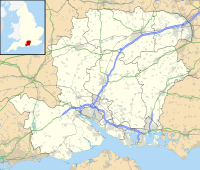St Mary's Church, Itchen Stoke
| St Mary, Itchen Stoke | |
|---|---|
| St Mary's Church, Itchen Stoke, Hampshire | |

The church of St Mary seen from the west
|
|
| Coordinates: 51°05′18″N 1°12′11″W / 51.0884°N 1.2031°W | |
| OS grid reference | SU 559 323 |
| Location | Itchen Stoke, Hampshire |
| Country | England |
| Denomination | Anglican |
| Website | [1] |
| History | |
| Founded | 1866 |
| Founder(s) | Rev. Charles Conybeare |
| Dedication | Saint Mary |
| Dedicated | 1866 |
| Consecrated | 1866 |
| Architecture | |
| Functional status | Redundant |
| Heritage designation | Grade II* |
| Designated | 1 March 1972 |
| Architect(s) | Henry Conybeare |
| Architectural type | Church |
| Style | Gothic revival |
| Groundbreaking | 1866 |
| Completed | 1866 |
| Construction cost | £7,000 |
| Specifications | |
| Materials | brown and grey stone, slate roof |
St Mary, Itchen Stoke, Hampshire, is a redundant Anglican church in the parish of Itchen Stoke and Ovington. It has been designated by English Heritage as a Grade II* listed building, and is under the care of the Churches Conservation Trust.
St Mary is the third church to have been built in the village of Itchen Stoke. The first was built before 1270 on a site near the River Itchen, but it suffered from damp, became dilapidated and was pulled down around 1830. Some traces of it remain. The second church which replaced it was built on land in the centre of the village which was donated for the purpose by Lord Ashburton, who held the advowson. Charles Ranken Conybeare, son of the geologist William Daniel Conybeare, became the incumbent in April 1857, but he took a dislike to the church, complaining that it was cold and damp, and that remedying these defects would be more expensive than demolishing and replacing it. Consent for the demolition was given by the Bishop of Winchester and the new Lord Ashburton, and the present church was erected on the same site in 1866.
The architect of the new church was Charles Conybeare's younger brother Henry Conybeare, a civil engineer with an interest in Gothic architecture, who had designed the Afghan Church in Colaba, Mumbai, where he had also been responsible for improving the city's sanitation.
...
Wikipedia

